Company Cyber Security Posture
NANA
NA Company Details
NA
NA
NA
NA
NA
NA
Scan still pending
NA
NA
Between 200 and 800
This score is AI-generated and less favored by cyber insurers, who prefer the TPRM score.
 NA Global Score
NA Global Score.png)

Company Scoring based on AI Models
| Model Name | Date | Description | Current Score Difference | Score |
|---|---|---|---|---|
| AVERAGE-Industry | 03-12-2025 | This score represents the average cybersecurity rating of companies already scanned within the same industry. It provides a benchmark to compare an individual company's security posture against its industry peers. | N/A | Between 200 and 800 |
Company Cyber Security News & History
| Entity | Type | Severity | Impact | Seen | Url ID | Details | View |
|---|
Company Subsidiaries

NA
Access Data Using Our API

Get company history
.png)
NA Cyber Security News
Maharashtra Aims for Trillion-Dollar Economy with AI, Startups
Mumbai, Feb 28 (PTI) The Maharashtra government is making special efforts to promote fintech and Artificial Intelligence start-ups as it ...
Keshav Reddy to launch a consent-first platform Equal
“ Equal aims to bring a change in how India perceives and manages personal identification while maintaining a standard in data-privacy security, ...

NA Similar Companies

Oxy
Oxy is an international energy company with assets primarily in the United States, the Middle East and North Africa. We are one of the largest oil producers in the U.S., including a leading producer in the Permian and DJ basins, and offshore Gulf of Mexico. Our midstream and marketing segment provid

PEMEX
Petróleos Mexicanos es la mayor empresa de México, el mayor contribuyente fiscal del país, así como una de las empresas más grandes de América Latina. Es de las pocas empresas petroleras del mundo que desarrolla toda la cadena productiva de la industria, desde la exploración, hasta la distribució

Weatherford
Weatherford International plc (Nasdaq: WFRD) is a leading global energy services company. Operating in approximately 75 countries, the Company answers the challenges of the energy industry with its global talent network of approximately 17,000 team members and approximately 350 operating locations,

Desco Incorporated
We are an energy service company which caters to the needs of geothermal, oil and gas projects. Our company provides products and services which introduce value-added propositions and integrated solutions to our clients' requirements. DESCO is a licensee of Cameron to manufacture WKM Geothermal G

NOV
NOV delivers technology-driven solutions to empower the global energy industry. For more than 150 years, NOV has pioneered innovations that enable its customers to safely produce abundant energy while minimizing environmental impact. The energy industry depends on NOV’s deep expertise and technology

YPF
En YPF, tenemos un Plan 4x4 para convertirnos en una compañía de clase mundial y lograr transformarnos en grandes exportadores de hidrocarburos. Nuestros cuatro pilares son: la aceleración de la producción de petróleo en Vaca Muerta, el activo más importante que tiene nuestro país; la disciplina f

Frequently Asked Questions
Explore insights on cybersecurity incidents, risk posture, and Rankiteo's assessments.
NA CyberSecurity History Information
How many cyber incidents has NA faced?
Total Incidents: According to Rankiteo, NA has faced 0 incidents in the past.
What types of cybersecurity incidents have occurred at NA?
Incident Types: The types of cybersecurity incidents that have occurred include .
Additional Questions
What Do We Measure?
















Every week, Rankiteo analyzes billions of signals to give organizations a sharper, faster view of emerging risks. With deeper, more actionable intelligence at their fingertips, security teams can outpace threat actors, respond instantly to Zero-Day attacks, and dramatically shrink their risk exposure window.
These are some of the factors we use to calculate the overall score:
Identify exposed access points, detect misconfigured SSL certificates, and uncover vulnerabilities across the network infrastructure.
Gain visibility into the software components used within an organization to detect vulnerabilities, manage risk, and ensure supply chain security.
Monitor and manage all IT assets and their configurations to ensure accurate, real-time visibility across the company's technology environment.
Leverage real-time insights on active threats, malware campaigns, and emerging vulnerabilities to proactively defend against evolving cyberattacks.




